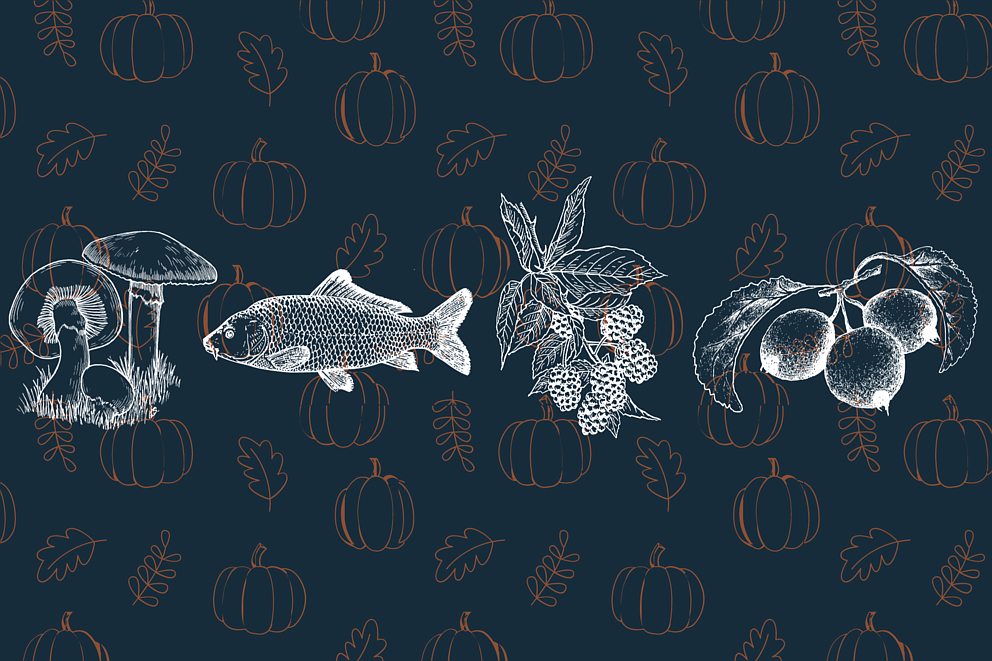Unconventional Pacific Northwest-inspired Holiday Recipes
November 23, 2023 at 8:36 a.m.
This article was edited for length by Michelle Roedell
Thanksgiving is known for turkey, stuffing, cranberry sauce and pumpkin pie. But what if your Thanksgiving spread (or meals throughout the holiday season) also included foods native to the Pacific Northwest region, like crabapples or mushrooms?
Indigenous tribes called the Americas home long before the first white settlers arrived, and the history of Thanksgiving is less amicable – and much bloodier– than what gets taught in schools. While the Thanksgiving feast is a myth, local foods can provide a gateway to learn about the region’s environment and history.
More than 280 plants, animals, fish and marine life across the Puget Sound region are used in traditional Coastal Salish diets, according to the University of Washington’s Burke Museum. Some of the traditional “First Foods” have remained staples in the Northwest, but others have fallen out of modern cuisines after colonizers forcefully displaced Indigenous peoples and disrupted the dietary systems, traditions and knowledge that tribes had developed for millennia.
As you head into the kitchen, here are a few ways to incorporate local Pacific Northwest foods into your Thanksgiving feast.
Crabapple Jelly
This year, skip the canned cranberry sauce for a homemade jelly using one of Washington’s most iconic foods. Well, sort of iconic. Washington is an apple powerhouse, with an expected harvest of over 5,360 million pounds this season. But none of the glossy varieties lining grocery shelves are native to the Pacific Northwest. Before the first orchard was planted by settlers 200 years ago, the only apple found in Washington was a single species of crabapple.
The Pacific crabapple tree (malus fusca) produces a sour fruit that looks a lot like a cherry. Unsuited to the combination of lava soil and arid climate east of the Cascades that is ideal for modern orchards, the Pacific crabapple thrives in wet habitats like coastal coniferous forests and wetlands.
Crabapples were a traditional food for the Indigenous peoples living in what is now Washington and British Columbia. The Quileute word for crabapple – siyoy9xnidax – translates to “hurts the tongue.” Some communities preferred crabapples raw, while others cooked, mashed or preserved the fruit to eat alone or with seafood.
Ingredients
- 1 lb collected crabapples
- Water
- Sugar
- Rosemary, cooking lavender, chopped jalapeño peppers or other flavoring if desired
Notes
Crabapples are not typically grown as commercial crops or sold at retail groceries. Many varieties can be found in the wilderness, in public parks or on urban street trees.
Directions
Extract juice:
- Wash and halve 1 lb collected crabapples (no need to core). Add to a pot with 1 cup water.
- To make flavored jelly, add about a teaspoon of rosemary, cooking lavender, or chopped jalapeño chili pepper to the mixture.
- Simmer for about 20 minutes over low heat without stirring.
- Strain the mixture with cheesecloth or a mesh strainer. Discard skin, seeds and other solids.
Set:
- Measure the juice and add an equivalent amount of sugar. For instance, if your fruit yields 1 ½ cups juice, add 1 ½ cups sugar. Stir and return to medium heat.
- Stir the mixture as it comes to a boil and gently skim any white foam from the top.
- Thicken the gel, stirring constantly, for about 10 minutes.
- Let the mixture cook, then pour the jelly into clean jars.
Mushrooms
This Thanksgiving, Pacific Northwest home cooks can bring savory local flavors to their holiday tables by incorporating Seattle-grown mushrooms into traditional dishes or concocting brand-new mushroom-centric recipes.
For thousands of years Coast Salish and Quinault peoples harvested wild mushrooms like chanterelles, morels and oysters. These mushrooms can be found growing in the shady, dark forests of the Seattle region around Whidbey Island and Snohomish County. Now, local farms, like Marrowstone Mushrooms, are cultivating varieties of woodland mushrooms and distributing them across the Puget Sound region to households and restaurants.
Seattle’s Marrowstone Mushrooms grows about 600 pounds of wood-based mushrooms within the city limits each week. Owner Ben Jaffe recommends mixing multiple varieties to increase the depth of flavors when making dishes like cream of mushroom soup or adding them to a stuffing.
For an impressive Thanksgiving centerpiece, Jaffe slow-cooks a whole Lion’s Mane mushroom like a brisket, braising it in a barbecue sauce base. But Jaffe’s secret to developing flavor and texture is letting it refrigerate overnight. Sliced and heated, it shines as a vegetarian main.
Aside from plant-based mains, mushrooms are easily incorporated into appetizers, sides and traditional dishes. “Mushrooms pair well with almost any Thanksgiving dish,” Jaffe said. Wild varieties like chanterelles can amplify the flavor of classic stuffing, and a cream of mushroom soup made with a blend of local mushrooms can make a delicious starter or a classic addition to a green bean casserole.
Seeking regional mushrooms at farmers markets, through home delivery services or directly from local farms provides opportunities to support sustainable agriculture. In Jaffe’s view, “If you haven’t eaten mushrooms this week, consider buying some mushrooms and eating some mushrooms. They’re good for you, and you’re supporting a better world.”
Here is Jaffe’s go-to recipe for a simple mushroom satay or gravy.
SIMPLE MUSHROOM SATAY OR GRAVY
Ingredients
- Mushrooms (any variety), 1 cup
- Onion
- Butter (or heart-healthy vegan butter), ¼ stick
- Garlic, 3 cloves minced
- Paprika (to taste)
- Black pepper (to taste)
- Salt (to taste)
For gravy:
- 2 tbsp butter
- 4 tbsp flour
- 2 cups of broth
Directions
- Finely dice mushrooms and onions while melting butter over medium heat
- Keep pan on medium heat and sweat out the mushrooms, adding additional oil as needed.
- Add desired spices to taste, continuing to stir occasionally for 10-20 minutes or until mushrooms can be served as a side, spread on crackers, or added to other dishes.
To turn these mushrooms into gravy:
- Using same skillet, melt an additional ¼ stick of butter on low heat.
- Make a roux by slowly adding 4 tbsp of flour and whisking until you have a nice thick paste.
- Slowly add broth while stirring vigorously to avoid the buildup of flour chunks.
- Cook for an additional 2-5 minutes until sauce thickens to desired consistency.
- Add cooked mushroom and onion mix to sauce.
- Simmer until desired thickness is reached or until ready to eat.
Marionberry Pie
What’s Thanksgiving without pie? Though apple and pumpkin typically reign supreme during this holiday, try adding a twist to your dinner spread by letting the Pacific Northwest marionberry shine instead.
The marionberry looks just like the blackberry, but while the common blackberry has existed for a long time (Indigenous communities used them as food, medicine and dye for crafts), the marionberry was created in the 1940s at Oregon State University. Yes, created — it’s a hybrid of the Chehalem blackberry and the olallieberry and originated in Marion County, Oregon (hence its name).
Marionberries are grown exclusively in Oregon and known as a summer fruit, harvested in mid-July. In 2017, Oregon made marionberry pie the state’s official pie.
The marionberry is known for its balance of sweet and sour, with an earthy sweetness. While its flavor shines, it’s quite fragile and does not travel well, which is why it’s not widely known outside of the Pacific Northwest. They still work great as a pie filling; they just need to be treated with extra care, notes the owner of Rumbly in my Tumbly Pie Company, Shannon McDowell. Her Lynnwood shop won Best Dessert in KING 5’s 2023 Best of Western Washington competition, voted by viewers.
For McDowell, who started her pre-order pie shop officially in 2021, the marionberry shines on its own.
“Marionberries are one of the very few berries where you just don’t have to add anything,” McDowell said. “So many berries you have to add a little bit of lemon zest or cinnamon or something to it to make it stand out, but I don’t add anything to marionberry because the flavor’s just so good.”
To make marionberry pie, you need frozen marionberries, but McDowell warns that they can’t be found in normal grocery stores. She recommends going to a CHEF’STORE or sourcing them from a local farm, such as Remlinger Farms in Carnation. After getting the frozen berries, McDowell defrosts them in the fridge overnight and then drains the excess juice.
The key to any pie, according to McDowell, is a good handmade crust.
“It’s something that anybody can do if they just follow directions and practice a little bit. It’s a fairly simple thing to do,” McDowell said. “It has to be made by hand. If you buy the Pillsbury stuff or the stuff that’s store-bought, it’s never as good. So to me, that’s the key to good pies. The whole thing is the crust … nobody just wants to eat pie filling.”
Here is McDowell’s recipe for a flaky marionberry pie.
MARIONBERRY PIE
Ingredients
For the pie crust:
- ½ cup cold salted butter, cubed (or heart-healthy vegan butter)
- ½ cup cold leaf lard or heart-healthy vegetable shortening, cubed
- 2 2/3 cups all purpose flour
- 1 tsp salt
- About ½ cup of water
- 6 cups of frozen marionberries, thawed in the refrigerator overnight and drained
- 1 tablespoon tapioca starch
- 1 cup granulated sugar
- 1/3 cup all-purpose flour
Directions
- Using a pastry blender or food processor, pulse the butter, lard and salt together until coarse crumbs form. You can see a video of how to make this pie crust on the Rumbly in my Tumbly Facebook page. Slowly add the water a couple of tablespoons at a time while continuing to pulse, until your dough comes together in a ball. Avoid overworking your dough. Pulse the food processor only until the ball starts to form.
- Make your filling by mixing the filling ingredients together (gently; marionberries break very easily).
- Divide the dough into two parts, roll the first ball out on a well-floured surface into a round approximately 11 inches wide, and place it into a 9-inch pie plate. Add the filling, roll out your top crust and place on top.
- Cut off any dough that extends more than about a half-inch from the rim of the pie plate, then press the top and bottom crust together and fold them underneath around the rim. Crimp the edges with your thumb. Slit the top crust for steam to escape. Brush the top crust with either heavy cream or a beaten egg wash and sprinkle with course sanding sugar.
- Bake at 375 degrees F for one hour. Let cook before serving.
Read the full Crosscut article with its additional recipe for smoked salmon cheese log at this link: 4 unconventional Pacific Northwest-inspired Thanksgiving recipes | Crosscut
Visit crosscut.com/donate to support nonprofit, freely distributed, local journalism.





